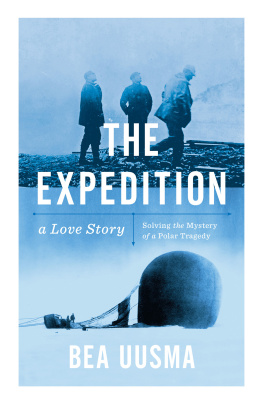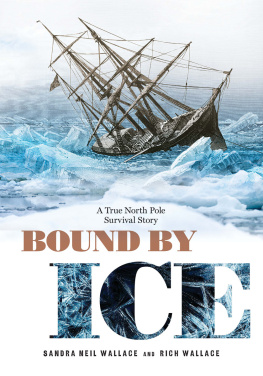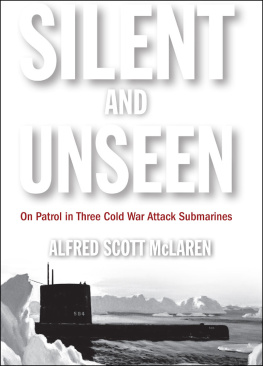


www.headofzeus.com
To read this book as the author intended and for a fuller reading experience turn on publishers font in your text display options.

Contents
The Andre expedition and I
At the edge of the Arctic Ocean, on a beach in full colour
Into the arctic pack ice
Where no one has been before and no shadows fall
What happened to the people left behind
The expedition is discovered by coincidence and my search enters a new phase
Messages in the crumbling diaries
An unknown protocol
I search for fragments to analyse
Things I did and possibly regretted in hindsight
I complete a jigsaw
In which I finally make it there
A love story comes to a very sad end

Everything in this book is true. It all really happened.
Except pages 240
I hate being cold. The mere thought of going outside without mittens on a windy day makes me panic. When the temperature drops below freezing I prefer to stay indoors. I used to work as an illustrator. Then I studied to be a doctor. I buy extra warm socks for my children, so they wont be cold either. I spend hours in the bath. I load the dishwasher. I cant be bothered to load the dishwasher. I have a bus pass and a door code and a fixed mortgage rate. I have a day planner and a play list for jogging and every day, for fifteen years, I have ached to go to this one desolate island, a shard of white in the Arctic Ocean. The island is completely uninhabited and buried under a glacier that falls sharply away into the sea, sheer like a cliff face. Its sometimes called the inaccessible island, because its always embedded in pack ice. Three times Ive tried to reach it, but every time weve come close weve been forced to turn back or risk our ship getting stuck or being crushed by the immense, mint green ice floes. Nothing grows on this island, but at its southern tip theres a narrow stony beach, free from ice, a tiny spit of land jutting out into the sea. Theres nothing on this beach but crushed rock and gravel, a few pieces of driftwood, and its to this particular beach I want, no, not want, have to go.
I have longed for this beach for fifteen years. I have to get there, even though I dont know what Ill do once Im finally there. Once Im finally on White Island.
IT WAS SOME LAME PARTY in the early nineties; I had ended up slumped in an armchair. I took a book down from a bookshelf: Andres Story: The Complete Record of His Polar Flight, 1897 . I started reading. Then I got up out of the armchair and went home. I took the book with me. It has been on my bookshelf ever since. For over fifteen years I have been unable to stop thinking about the Andre expedition: three men from Stockholm, who disappeared on their way to the North Pole in a hydrogen balloon. The remnants of their final camp were found 33 years later, frost-bound on a desolate island in the middle of the Arctic Sea. Three skeletons, a small, tattered tent. The more I learn about their story, the more real it seems, like a black and white photograph gradually filling with colour.
The history of polar exploration is full of heroic expeditions. At the end of the nineteenth century, when the Arctic and Antarctica were still white spots on the world map, there was no shortage of men who would bravely throw themselves into the unknown. Hard men with hoar frost in their beards Nansen, Amundsen, Nordenskild who after unthinkable trials returned as national heroes. Royal honours. Happy endings. The Andre expedition was nothing like that. With hindsight it is clear they should never have set out at all.
A few weeks after the party, I was driving from Stockholm to Gothenburg. About halfway there, as I was passing Grnna, I stopped by the Andre Museum. Something happened to me when I saw the expeditions gear with my own eyes for the first time. I walked from display to display for hours, ogling tin cans scarred by polar bear teeth and sledges with improvised repairs. Back in my car on highway 40 I kept my eyes on the road, but I could not stop thinking about what I had seen. I tried to talk sense into myself, but I was like a vampire tasting human blood for the first time. It became my expedition.
I returned to the museum. I began buying books about the Andre expedition in second-hand book shops. I began searching for something, without really knowing what. The only thing I knew was that I had to get inside the expedition, as deep inside as I possibly could. When there were no more books to read I turned to the original documents from the end of the nineteenth century in the museums archive: from Andres hotel bills and order forms, wills and records of maritime declaration hearings to love letters, each page crammed heartbreakingly full, and private messages on the backs of photographs. I have stared at ugly little school drawings of dogs, without understanding what I was looking for. And still I have kept on searching. The youngest member of the expedition was newly engaged when he disappeared. I have met with his relatives. And hers. I have tracked the lives of the three explorers, gone through parish registers, land registry records and Stockholms civil census data. I have visited the houses where they lived. Stood in their stairwells.
There is a mystery at the heart of the story of the expedition, which remains unsolved: we dont know why they died. It is like a medical whodunit: at 1.46pm on 11th July 1987 the balloon the Eagle took off from Spitsbergen and disappeared into the clouds, heading north. Four days later one of their homing pigeons returned. A few buoys washed ashore along the coast. Then there was only silence, for 33 years. The bodies of the members of the expedition were found by accident in 1930 on White Island, an uninhabited island in the Arctic. Their diaries, found at the campsite, tell of how they were forced to make an emergency landing, just three days after take-off, setting their leaking balloon down in the middle of the arctic pack ice, and of how they man-hauled their sledges, each weighing many hundreds of pounds, across the ice for three months, perpetually cold and wet, in an attempt to make it back to dry land. Once they reached White Island, after 87 days of inhuman exertion, all entries cease. They had ample provisions, warm clothing, functioning weapons and several crates of ammunition. But the three members of the expedition died, before they had even unloaded their sledges.
The pages of the diaries, frozen solid on White Island, have been successfully preserved, so the text is actually still legible. The rolls of film found in the camp could be developed, even though they had been buried under a blanket of snow for over three decades. But despite the diary entries and the photographs taken while on the ice, no one has been able to solve the mystery of how the members of the Andre expedition met their end. As soon as they stepped onto dry land on White Island, something happened. Something they did not write about. Ever since 1897, writers, journalists, doctors and polar researchers have tried to determine what really happened. But no one has been able to scientifically prove the cause of their death.
Next page














